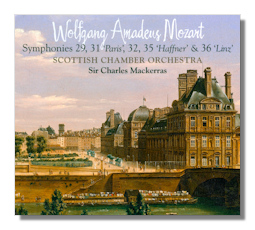
The Internet's Premier Classical Music Source
Related Links
- Mozart Reviews
- Latest Reviews
- More Reviews
-
By Composer
-
Collections
DVD & Blu-ray
Books
Concert Reviews
Articles/Interviews
Software
Audio
Search Amazon
Recommended Links
Site News
 SACD Review
SACD Review
Wolfgang Mozart

Symphonies II
- Symphony #29 in A Major, K. 201
- Symphony #31 "Paris" in D Major, K. 297
- Symphony #32 in G Major, K. 318
- Symphony #35 "Haffner" in D Major, K. 385
- Symphony #36 "Linz" in C Major, K. 425
Scottish Chamber Orchestra/Sir Charles Mackerras
Linn CKD350 Two Hybrid Multichannel SACDs 116:57
One of the most difficult tasks for a reviewer is to tackle new performances of well-worn repertoire. With literally hundreds of recordings of these works in the catalogs, is there really much new to say? Luckily, both the quality of these performances and the outstanding audio fidelity allow an answer in the definite affirmative.
Sir Charles Mackerras is not new to this repertoire – he has lived with it for decades in the concert hall and the recording studio. His acclaimed survey with the Prague Chamber Orchestra for Telarc has been a benchmark period-informed modern-instrument performance for nearly two decades. His place as a leading interpreter of Mozart's symphonies is secure, as his legacy is expanded with this new survey.
Mackerras' latest foray into Mozart's symphonies comes from the audiophile recording label (and equipment manufacturer) Linn. With company headquarters near Glasgow, it was logical that they should tap the considerable virtuosity of the Scottish Chamber Orchestra for this new cycle. Sir Charles and the SCO have a long association dating back more than two decades. The first volume from Linn (CKD308) containing symphonies #38-41 has already been released to critical acclaim, winning the Critics Award at the 2009 BRIT Awards, named Disc of the Year at the 2009 BBC Music Magazine Awards, as well as receiving the Midem and Choc de l année Awards.
In preparation for this recording, Sir Charles merged his considerable knowledge of these works, with scores and parts he has been editing from available sources for years. The result is a definitive view of these works from Mackerras. The SCO has recorded a wide range of music with Mackerras over the years, including works by Arriaga, Kodály, Brahms, Vorisek, Handel, Schubert, Weber, Bartók, Field, and Beethoven.
Symphony #29 for 2 oboes, 2 horns, and strings, completed in 1774 and dating from his Salzburg years, is one of Mozart's first mature symphonies. Mackerras has relaxed his interpretation of this piece somewhat from his previous effort with the Prague Chamber Orchestra. Tempos are bit broader, but never plodding. As he did with the PCO, a period approach is taken, but modern instruments are used. Mackerras maintains drama and tension throughout, revealing telling inner lines that were a bit more glossed over in earlier performances. All repeats are taken.
Symphony #31 was composed for a larger orchestra consisting of 2 flutes, 2 oboes, 2 clarinets, 2 bassoons, 2 horns, 2 trumpets, timpani, and strings and completed in Paris for the Concerts Spirituel in 1778, hence its nickname. This symphony was the result of a commission by the Parisian impresario Joseph Legros, organizer of the Concerts Spirituel. In Paris, Mozart had access to larger instrumental forces, including clarinets, and he makes the most of his opportunity with French-pleasing special effects and brilliant orchestration.
This recording includes both versions of the 2nd movement of the Paris Symphony; apparently Sir Charles requested that the alternative version follows the original, rather than coming at the end of the album as an appendix. This rather unusual arrangement makes for odd listening if one is familiar with the work. The andante following the andantino throws off the symmetry of the work. But this can be fixed by programming the tracks in the desired order.
Symphony #32 "Overture in the Italian Style" is scored for 2 flutes, 2 oboes, 2 bassoons, 4 horns, 2 trumpets, timpani, and strings. It was finished in Salzburg on April 26, 1779. Despite the obvious dramatic content of this short symphony, it is sometimes referred to as an "overture in the Italian style" though there is no such designation on the manuscript and no evidence that Mozart intended the work to be anything other than a standalone symphonic piece.
Symphony #35 "Haffner" designates the same instrumentation as for the Paris symphony though it was completed in Vienna in July 1782. Mackerras takes a slightly more relaxed approach to this symphony than his previous survey, and the interpretation benefits from his grand conception.
Symphony #36 "Linz", completed Oct-Nov 1783, is scored for a slightly smaller orchestra – specifically the forces he had available in Linz (2 oboes, 2 bassoons, 2 horns, 2 trumpets, timpani, and strings). Mackerras' tempos are even more stately here than in the Haffner symphony, bringing the symphony in at nearly five minutes longer than in the Telarc series.
Sir Charles' decades of musical research has allowed him to make performing editions of these symphonies in preparation for this recording. But it is his close, synergistic relationship with the Scottish Chamber Orchestra, an ensemble whose reputation seems to have only expanded in the past couple of decades, and the sound quality captured by Linn's engineers, that has brought forth perhaps the finest recordings of these works I know.
Copyright © 2010, L. David Lampson





















